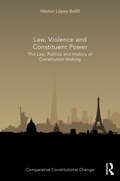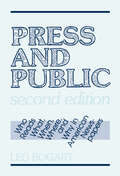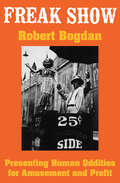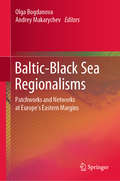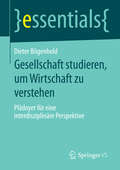- Table View
- List View
Law, Violence and Constituent Power: The Law, Politics And History Of Constitution Making (Comparative Constitutional Change)
by Héctor López BofillThis book challenges traditional theories of constitution-making to advance an alternative view of constitutions as being founded on power which rests on violence. The work argues that rather than the idea of a constitution being the result of political participation and deliberation, all power instead is based on violence. Hence the creation of a constitution is actually an act of coercion, where, through violence, one social group is able to impose itself over others. The book advocates that the presence of violence be used as an assessment of whether genuine constitutional transformation has taken place, and that the legitimacy of a constitutional order should be dependent upon the absence of killing. The book will be essential reading for academics and researchers working in the areas of constitutional law and politics, legal and political theory, and constitutional history.
Law, Violence and Constituent Power: The Law, Politics And History Of Constitution Making (Comparative Constitutional Change)
by Héctor López BofillThis book challenges traditional theories of constitution-making to advance an alternative view of constitutions as being founded on power which rests on violence. The work argues that rather than the idea of a constitution being the result of political participation and deliberation, all power instead is based on violence. Hence the creation of a constitution is actually an act of coercion, where, through violence, one social group is able to impose itself over others. The book advocates that the presence of violence be used as an assessment of whether genuine constitutional transformation has taken place, and that the legitimacy of a constitutional order should be dependent upon the absence of killing. The book will be essential reading for academics and researchers working in the areas of constitutional law and politics, legal and political theory, and constitutional history.
Neolithic Farming in Central Europe: An Archaeobotanical Study of Crop Husbandry Practices
by Amy BogaardNeolithic Farming in Central Europe examines the nature of the earliest crop cultivation, a subject that illuminates the lives of Neolithic farming families and the day-to-day reality of the transition from hunting and gathering to farming. Debate surrounding the nature of crop husbandry in Neolithic central Europe has focussed on the permanence of cultivation, its intensity and its seasonality: variables that carry different implications for Neolithic society. Amy Bogaard reviews the archaeological evidence for four major competing models of Neolithic crop husbandry - shifting cultivation, extensive plough cultivation, floodplain cultivation and intensive garden cultivation - and evaluates charred crop and weed assemblages. Her conclusions identify the most appropriate model of cultivation, and highlight the consequences of these agricultural practices for our understanding of Neolithic societies in central Europe.
Neolithic Farming in Central Europe: An Archaeobotanical Study of Crop Husbandry Practices
by Amy BogaardNeolithic Farming in Central Europe examines the nature of the earliest crop cultivation, a subject that illuminates the lives of Neolithic farming families and the day-to-day reality of the transition from hunting and gathering to farming. Debate surrounding the nature of crop husbandry in Neolithic central Europe has focussed on the permanence of cultivation, its intensity and its seasonality: variables that carry different implications for Neolithic society. Amy Bogaard reviews the archaeological evidence for four major competing models of Neolithic crop husbandry - shifting cultivation, extensive plough cultivation, floodplain cultivation and intensive garden cultivation - and evaluates charred crop and weed assemblages. Her conclusions identify the most appropriate model of cultivation, and highlight the consequences of these agricultural practices for our understanding of Neolithic societies in central Europe.
The Bhopal Tragedy: Language, Logic, And Politics In The Production Of A Hazard
by William BogardThis book offers a critical theory of hazards, which the Bhopal tragedy would serve to highlight. It provides a general model of how hazards existed in Bhopal come to be defined and symbolically manipulated—through the institutionalized use of expert knowledge and political persuasion.
The Bhopal Tragedy: Language, Logic, And Politics In The Production Of A Hazard
by William BogardThis book offers a critical theory of hazards, which the Bhopal tragedy would serve to highlight. It provides a general model of how hazards existed in Bhopal come to be defined and symbolically manipulated—through the institutionalized use of expert knowledge and political persuasion.
Commercial Culture: The Media System and the Public Interest
by Leo BogartAmerican mass media are the world's most diverse, rich, and free. Their dazzling resources, variety, and influence arouse envy in other countries. Their failures are commonly excused on the grounds that they are creatures of the market, that they give people what they want. 'Commercial Culture' focuses not on the glories of the media, but on what is wrong with them and why, and how they may be made better. This powerful critique of American mass communication highlights four trends that sound an urgent call for reform: the blurring of distinctions among traditional media and between individual and mass communication; the increasing concentration of media control in a disturbingly small number of powerful organizations; the shift from advertisers to consumers as the source of media revenues; and the growing confusion of information and entertainment, of the real and the imaginary. The future direction of the media, Leo Bogart contends, should not be left to market forces alone. He shows how the public's appetite for media differs from other demands the market is left to satisfy because of how profoundly the media shape the public's character and values. Bogart concludes that a world of new communications technology requires a coherent national media policy, respectful of the American tradition of free expression and subject to vigorous public scrutiny and debate. 'Commercial Culture' is a comprehensive analysis of the media as they evolve in a technological age. It will appeal to general readers interested in mass communications, as well as professionals and scholars studying American mass media.
Commercial Culture: The Media System and the Public Interest
by Leo BogartAmerican mass media are the world's most diverse, rich, and free. Their dazzling resources, variety, and influence arouse envy in other countries. Their failures are commonly excused on the grounds that they are creatures of the market, that they give people what they want. 'Commercial Culture' focuses not on the glories of the media, but on what is wrong with them and why, and how they may be made better. This powerful critique of American mass communication highlights four trends that sound an urgent call for reform: the blurring of distinctions among traditional media and between individual and mass communication; the increasing concentration of media control in a disturbingly small number of powerful organizations; the shift from advertisers to consumers as the source of media revenues; and the growing confusion of information and entertainment, of the real and the imaginary. The future direction of the media, Leo Bogart contends, should not be left to market forces alone. He shows how the public's appetite for media differs from other demands the market is left to satisfy because of how profoundly the media shape the public's character and values. Bogart concludes that a world of new communications technology requires a coherent national media policy, respectful of the American tradition of free expression and subject to vigorous public scrutiny and debate. 'Commercial Culture' is a comprehensive analysis of the media as they evolve in a technological age. It will appeal to general readers interested in mass communications, as well as professionals and scholars studying American mass media.
Press and Public: Who Reads What, When, Where, and Why in American Newspapers
by Leo BogartThis book reviews the challenges that face American newspapers at the end of the 1980s, after a decade of circulation losses for many dailies and several decades of accelerating social change. It describes how content of newspapers is changing in the context of a discussion of the nature of news.
Press and Public: Who Reads What, When, Where, and Why in American Newspapers
by Leo BogartThis book reviews the challenges that face American newspapers at the end of the 1980s, after a decade of circulation losses for many dailies and several decades of accelerating social change. It describes how content of newspapers is changing in the context of a discussion of the nature of news.
Europe and the Roma: A History of Fascination and Fear
by Klaus-Michael Bogdal‘A magisterial contribution to the understanding of the cultural position of Romani people in Europe. … nothing short of astounding’ Literary ReviewThis remarkable book describes a dark side of European history: the rejection of the Roma from their initial arrival in the late Middle Ages to the present day. To Europeans, the Roma appeared to be in complete contradiction with their own culture, because of their mysterious origins, unknown language and way of life. As representatives of an oral culture, for centuries the Roma have left virtually no written records of their own. Their history has been conveyed to us almost exclusively through the distorted images that European cultures project.Persecuted and shunned, the Roma nonetheless spread out across the continent and became an important, indeed indispensable element in the European imagination. It is impossible to conceive of the culture of Spain, southern France and much of Central Europe without this pervasive Romani influence.Europe and the Roma brilliantly describes the 'fascination and fear' which have marked Europeans' response to the Romani presence. Countless composers, artists and writers have responded to Romani culture and to fantasies thereof. Their projections onto a group whose illiteracy and marginalization gave it so little direct voice of its own have always been a very uneasy mixture of the inspired, the patronizing and the frighteningly ignorant. The book also shows the link between cultural violence, social discrimination and racist policies that paved the way for the genocide of the Roma.
Freak Show: Presenting Human Oddities for Amusement and Profit
by Robert BogdanFrom 1840 until 1940, freak shows by the hundreds crisscrossed the United States, from the smallest towns to the largest cities, exhibiting their casts of dwarfs, giants, Siamese twins, bearded ladies, savages, snake charmers, fire eaters, and other oddities. By today's standards such displays would be considered cruel and exploitative—the pornography of disability. Yet for one hundred years the freak show was widely accepted as one of America's most popular forms of entertainment. Robert Bogdan's fascinating social history brings to life the world of the freak show and explores the culture that nurtured and, later, abandoned it. In uncovering this neglected chapter of show business, he describes in detail the flimflam artistry behind the shows, the promoters and the audiences, and the gradual evolution of public opinion from awe to embarrassment. Freaks were not born, Bogdan reveals; they were manufactured by the amusement world, usually with the active participation of the freaks themselves. Many of the "human curiosities" found fame and fortune, becoming the celebrities of their time, until the ascent of professional medicine transformed them from marvels into pathological specimans.
Freak Show: Presenting Human Oddities for Amusement and Profit
by Robert BogdanFrom 1840 until 1940, freak shows by the hundreds crisscrossed the United States, from the smallest towns to the largest cities, exhibiting their casts of dwarfs, giants, Siamese twins, bearded ladies, savages, snake charmers, fire eaters, and other oddities. By today's standards such displays would be considered cruel and exploitative—the pornography of disability. Yet for one hundred years the freak show was widely accepted as one of America's most popular forms of entertainment. Robert Bogdan's fascinating social history brings to life the world of the freak show and explores the culture that nurtured and, later, abandoned it. In uncovering this neglected chapter of show business, he describes in detail the flimflam artistry behind the shows, the promoters and the audiences, and the gradual evolution of public opinion from awe to embarrassment. Freaks were not born, Bogdan reveals; they were manufactured by the amusement world, usually with the active participation of the freaks themselves. Many of the "human curiosities" found fame and fortune, becoming the celebrities of their time, until the ascent of professional medicine transformed them from marvels into pathological specimans.
Freak Show: Presenting Human Oddities for Amusement and Profit
by Robert BogdanFrom 1840 until 1940, freak shows by the hundreds crisscrossed the United States, from the smallest towns to the largest cities, exhibiting their casts of dwarfs, giants, Siamese twins, bearded ladies, savages, snake charmers, fire eaters, and other oddities. By today's standards such displays would be considered cruel and exploitative—the pornography of disability. Yet for one hundred years the freak show was widely accepted as one of America's most popular forms of entertainment. Robert Bogdan's fascinating social history brings to life the world of the freak show and explores the culture that nurtured and, later, abandoned it. In uncovering this neglected chapter of show business, he describes in detail the flimflam artistry behind the shows, the promoters and the audiences, and the gradual evolution of public opinion from awe to embarrassment. Freaks were not born, Bogdan reveals; they were manufactured by the amusement world, usually with the active participation of the freaks themselves. Many of the "human curiosities" found fame and fortune, becoming the celebrities of their time, until the ascent of professional medicine transformed them from marvels into pathological specimans.
Freak Show: Presenting Human Oddities for Amusement and Profit
by Robert BogdanFrom 1840 until 1940, freak shows by the hundreds crisscrossed the United States, from the smallest towns to the largest cities, exhibiting their casts of dwarfs, giants, Siamese twins, bearded ladies, savages, snake charmers, fire eaters, and other oddities. By today's standards such displays would be considered cruel and exploitative—the pornography of disability. Yet for one hundred years the freak show was widely accepted as one of America's most popular forms of entertainment. Robert Bogdan's fascinating social history brings to life the world of the freak show and explores the culture that nurtured and, later, abandoned it. In uncovering this neglected chapter of show business, he describes in detail the flimflam artistry behind the shows, the promoters and the audiences, and the gradual evolution of public opinion from awe to embarrassment. Freaks were not born, Bogdan reveals; they were manufactured by the amusement world, usually with the active participation of the freaks themselves. Many of the "human curiosities" found fame and fortune, becoming the celebrities of their time, until the ascent of professional medicine transformed them from marvels into pathological specimans.
The Jewish Divide Over Israel: Accusers and Defenders
by Paul BogdanorBefore 1967, Israel had the overwhelming support of world opinion. So long as Israel's existence was in harmony with politically correct assumptions, it was supported, or at least accepted, by the majority of "progressive" Jews, especially in the wake of the Holocaust. This is no longer the case. "The Jewish Divide Over Israel" explains the role played by prominent Jews in turning Israel into an isolated pariah nation. After their catastrophic defeat in 1967, Arabs overcame inferiority on the battlefield with superiority in the war of ideas. Their propaganda stopped trumpeting their desire to eradicate Israel. Instead, in a calculated appeal to liberals and radicals, they redefined their war of aggression against the Jews as a struggle for the liberation of Palestinian Arabs. The tenacity of Arabs' rejection of Israel and their relentless campaign - in schools, universities, churches, professional organizations, and, above all, the news media - to destroy Israel's moral image had the desired impact. Many Jewish liberals became desperate to escape from the shadow of Israel's alleged misdeeds and found a way to do so by joining other members of the left in blaming Israeli sins for Arab violence. Today, Jewish liberals rationalize violence against the innocent as resistance to the oppressor, excuse Arab extremism as the frustration of a wronged party, and redefine eliminationist rhetoric and physical assaults on Jews as "criticism of Israeli policy." Israel's Jewish accusers have played a crucial and disproportionate role in the current upsurge of antisemitism precisely because they speak as Jews. The essays in this book seek to understand and throw back the assault on Israel led by such Jewish liberals and radicals as Tony Judt, Noam Chomsky, George Steiner, Daniel Boyarin, Marc Ellis, Israel Shahak, and many others. Its writers demonstrate that the foundation of the state of Israel, far from being the primal sin alleged by its accusers, was one of the few redeeming events in a century of blood and shame.
The Jewish Divide Over Israel: Accusers and Defenders
by Paul BogdanorBefore 1967, Israel had the overwhelming support of world opinion. So long as Israel's existence was in harmony with politically correct assumptions, it was supported, or at least accepted, by the majority of "progressive" Jews, especially in the wake of the Holocaust. This is no longer the case. "The Jewish Divide Over Israel" explains the role played by prominent Jews in turning Israel into an isolated pariah nation. After their catastrophic defeat in 1967, Arabs overcame inferiority on the battlefield with superiority in the war of ideas. Their propaganda stopped trumpeting their desire to eradicate Israel. Instead, in a calculated appeal to liberals and radicals, they redefined their war of aggression against the Jews as a struggle for the liberation of Palestinian Arabs. The tenacity of Arabs' rejection of Israel and their relentless campaign - in schools, universities, churches, professional organizations, and, above all, the news media - to destroy Israel's moral image had the desired impact. Many Jewish liberals became desperate to escape from the shadow of Israel's alleged misdeeds and found a way to do so by joining other members of the left in blaming Israeli sins for Arab violence. Today, Jewish liberals rationalize violence against the innocent as resistance to the oppressor, excuse Arab extremism as the frustration of a wronged party, and redefine eliminationist rhetoric and physical assaults on Jews as "criticism of Israeli policy." Israel's Jewish accusers have played a crucial and disproportionate role in the current upsurge of antisemitism precisely because they speak as Jews. The essays in this book seek to understand and throw back the assault on Israel led by such Jewish liberals and radicals as Tony Judt, Noam Chomsky, George Steiner, Daniel Boyarin, Marc Ellis, Israel Shahak, and many others. Its writers demonstrate that the foundation of the state of Israel, far from being the primal sin alleged by its accusers, was one of the few redeeming events in a century of blood and shame.
Baltic-Black Sea Regionalisms: Patchworks and Networks at Europe's Eastern Margins
by Olga Bogdanova Andrey MakarychevThis edited volume focuses on various forms of regionalism and neighborhoods in the Baltic-Black Sea area. In the light of current reshaping of borderlands and new geopolitical and military confrontations in Europe’s eastern margins, such as the annexation of Crimea and the war in Donbas, this book analyzes different types and modalities of regional integration and region-making from a comparative perspective. It conceptualizes cooperative and conflictual encounters as a series of networks and patchworks that differently link and relate major actors to each other and thus shape these interconnections as domains of inclusion and exclusion, bordering and debordering, securitization and desecuritization. This peculiar combination of geopolitics, ethnopolitics and biopolitics makes the Baltic-Black Sea trans-national region a source of inspiring policy practices, and, in the light of new security risks, a matter of increased concern all over Europe. The contributors from various disciplines cover topics such as cultural and civilizational spaces of belonging and identity politics, the rise of right-wing populism, region building under the condition of multiple security pressures, and the influence and regional strategies of different external powers, including the EU, Russia, and Turkey, on cross- and trans-regional relations in the area.
Qualitäten primärer Naturerfahrung und ihr Zusammenhang mit Umweltwissen und Umwelthandeln (Ökologie und Erziehungswissenschaft #5)
by Susanne BögeholzDeutungsmuster von Strafe: Eine strafsoziologische Untersuchung am Beispiel der Geldstrafe
by Nicole BögeleinNicole Bögelein rekonstruiert in ihrer empirischen Studie soziale Deutungsmuster von Strafe. Am Beispiel der am häufigsten verhängten Sanktion, der Geldstrafe, erkundet die Autorin, auf welche Deutungsmuster Verurteilte zurückgreifen, um ihre Strafe einzuordnen und zu bewerten. Wer eine Strafe erhält, wird mit strafrechtlichem Tadel versehen und als Abweichler und Normbrecher markiert. In dieser krisenhaften Situation rekurrieren Verurteilte auf Deutungsmuster zur Entlastung. Die Studie basiert auf diskursiven Interviews mit Personen, die zu einer Geldstrafe verurteilt sind, und diese durch Zahlung, gemeinnützige Arbeit oder Inhaftierung tilgen. Es zeigen sich sechs verschiedene Deutungsmuster, welche Strafe auf unterschiedliche Weise im Kontext von Moral, Legitimität und Gerechtigkeit verorten.
Mindful Parenting: A Guide for Mental Health Practitioners (Mindfulness in Behavioral Health)
by Susan Bögels Kathleen RestifoDespite its inherent joys, the challenges of parenting can produce considerable stress. These challenges multiply—and the quality of parenting suffers—when a parent or child has mental health issues, or when parents are in conflict. Even under optimal circumstances, the constant changes as children develop can tax parents' inner resources, often undoing the best intentions and parenting courses. Mindful Parenting: A Guide for Mental Health Practitioners offers an evidence-based, eight week structured mindfulness training program for parents with lasting benefits for parents and their children. Designed for use in mental health contexts, its methods are effective whether parents or children have behavioral or emotional issues. The program's eight sessions focus on mindfulness-oriented skills for parents, such as responding to (as opposed to reacting to) parenting stress, handling conflict with children or partners, fostering empathy, and setting limits. The book dovetails with other clinical mindfulness approaches, and is written clearly and accessibly so that professionals can learn the material easily and impart it to clients. Featured in the text: Detailed theoretical, clinical, and empirical foundations of the program.The complete Mindful Parenting manual with guidelines for eight sessions and a follow-up.Handouts and assignments for each session.Findings from clinical trials of the Mindful Parenting program.Perspectives from parents who have finished the course. Its clinical focus and empirical support make Mindful Parenting an invaluable tool for practitioners and clinicians in child, school, and family psychology, psychotherapy/counseling, psychiatry, social work, and developmental psychology.
Gesellschaft studieren, um Wirtschaft zu verstehen: Plädoyer für eine interdisziplinäre Perspektive (essentials)
by Dieter BögenholdDieter Bögenhold beschäftigt sich mit der Frage, wie die Fächer der Soziologie und Ökonomik zueinander positioniert sind. Nachdem zu Anfang des 20. Jahrhunderts eine strikte Einheit zwischen ihnen bestand, differenzierten und entkoppelten sich die beiden Fächer im Laufe der weiteren Jahrzehnte. Heute sieht es danach aus, als sei dieser Trend zum Stoppen gekommen. Immer stärker reintegriert die Ökonomik wieder Wissensgebiete und Methodiken der Soziologie, aber auch der Psychologie und der Historik. Hierin liegen zweifelsohne auch große Chancen für die Soziologie, die ihre Domänen und Kompetenzen reklamieren muss. Das Buch beinhaltet ein Plädoyer für interdisziplinäre Studien.
Consumption and Life-Styles: A Short Introduction
by Dieter Bögenhold Farah NazThis book takes an interdisciplinary approach to the world of consumption, covering different topics and including sociological, economic and marketing aspects. The term ‘consumption’ is vague and even in academic disciplines the term is used in a variety of ways. Consumption research asks how earnings and spending are related to each other. More generally, consumption research investigates how people, social classes or societies realize their consumption practices. The question of how consistent preference structures are due to changing empirical backgrounds of time, space and related culture is frequently asked. Which context variables (historical time, geographical framework, cultural background) specify the practice of consumption and in which way do attributes such as age, gender, class, occupation and life-style have their own impacts on the way in which consumption is realised?This book will be of interest to researchers working in economics, sociology, marketing, aesthetics and design, anthropology and communication studies.
Konsum und Lebensstile: Eine kurze Einführung
by Dieter Bögenhold Farah NazIn diesem Buch wird ein interdisziplinärer Ansatz für die Welt des Konsums gewählt, der verschiedene Themen abdeckt und soziologische, wirtschaftliche und marketingbezogene Aspekte einbezieht. Der Begriff "Konsum" ist vage, und selbst in den akademischen Disziplinen wird der Begriff auf unterschiedliche Weise verwendet. Die Konsumforschung fragt, wie Einkommen und Ausgaben miteinander zusammenhängen. Ganz allgemein untersucht die Konsumforschung, wie Menschen, soziale Schichten oder Gesellschaften ihre Konsumgewohnheiten realisieren. Häufig wird die Frage gestellt, wie konsistent Präferenzstrukturen aufgrund wechselnder empirischer Hintergründe von Zeit, Raum und damit verbundener Kultur sind. Welche Kontextvariablen (historischer Zeitpunkt, geographischer Rahmen, kultureller Hintergrund) spezifizieren die Praxis des Konsums und in welcher Weise haben Merkmale wie Alter, Geschlecht, Klasse, Beruf und Lebensstil eigene Auswirkungen auf die Art und Weise, wie Konsum realisiert wird?Das Buch ist für Forscher aus den Bereichen Ökonomie, Soziologie, Marketing, Ästhetik und Design, Anthropologie und Kommunikationswissenschaft von Interesse.
Ungehörte Stimmen: Frauen, Arbeit und politische Ökonomie der globalen Produktion
by Dieter Bögenhold Farah NazDieses Buch untersucht die Umstrukturierungen des Arbeitsmarktes und die Möglichkeiten, die sich aus der wirtschaftlichen Globalisierung ergeben haben. Die historischen, politischen, geografischen und sozialen Beziehungen, die Arbeitnehmerinnen innerhalb des Produktionsprozesses und der Politik der Arbeit haben, werden untersucht, um ein besseres Verständnis für die Rolle von Frauen innerhalb des globalen Produktionssystems und der internationalen Arbeitsteilung zu schaffen. Ungehörte Stimmen: Frauen, Arbeit und die politische Ökonomie der globalen Produktion zielt darauf ab, dem Leser ein Verständnis für neue Arbeitsplatzarrangements und die sich verändernden geschlechtsspezifischen Arbeitsmuster zu vermitteln. Das Buch ist für Forscher aus den Bereichen der VWL, Soziologie, Ethik, Marketing, Ästhetik und Design, Anthropologie und Kommunikationswissenschaft von Interesse.
